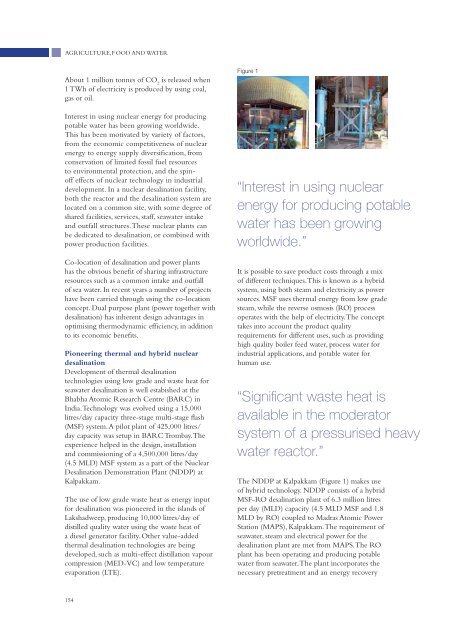Climate Action 2012-2013
Create successful ePaper yourself
Turn your PDF publications into a flip-book with our unique Google optimized e-Paper software.
AGRICULTURE, FOOD AND WATER<br />
About 1 million tonnes of CO 2<br />
is released when<br />
1 TWh of electricity is produced by using coal,<br />
gas or oil.<br />
Interest in using nuclear energy for producing<br />
potable water has been growing worldwide.<br />
This has been motivated by variety of factors,<br />
from the economic competitiveness of nuclear<br />
energy to energy supply diversification, from<br />
conservation of limited fossil fuel resources<br />
to environmental protection, and the spinoff<br />
effects of nuclear technology in industrial<br />
development. In a nuclear desalination facility,<br />
both the reactor and the desalination system are<br />
located on a common site, with some degree of<br />
shared facilities, services, staff, seawater intake<br />
and outfall structures. These nuclear plants can<br />
be dedicated to desalination, or combined with<br />
power production facilities.<br />
Co-location of desalination and power plants<br />
has the obvious benefit of sharing infrastructure<br />
resources such as a common intake and outfall<br />
of sea water. In recent years a number of projects<br />
have been carried through using the co-location<br />
concept. Dual purpose plant (power together with<br />
desalination) has inherent design advantages in<br />
optimising thermodynamic efficiency, in addition<br />
to its economic benefits.<br />
Pioneering thermal and hybrid nuclear<br />
desalination<br />
Development of thermal desalination<br />
technologies using low grade and waste heat for<br />
seawater desalination is well estabished at the<br />
Bhabha Atomic Research Centre (BARC) in<br />
India. Technology was evolved using a 15,000<br />
litres/day capacity three-stage multi-stage flash<br />
(MSF) system. A pilot plant of 425,000 litres/<br />
day capacity was setup in BARC Trombay. The<br />
experience helped in the design, installation<br />
and commissioning of a 4,500,000 litres/day<br />
(4.5 MLD) MSF system as a part of the Nuclear<br />
Desalination Demonstration Plant (NDDP) at<br />
Kalpakkam.<br />
The use of low grade waste heat as energy input<br />
for desalination was pioneered in the islands of<br />
Lakshadweep, producing 10,000 litres/day of<br />
distilled quality water using the waste heat of<br />
a diesel generator facility. Other value-added<br />
thermal desalination technologies are being<br />
developed, such as multi-effect distillation vapour<br />
compression (MED-VC) and low temperature<br />
evaporation (LTE).<br />
Figure 1<br />
“Interest in using nuclear<br />
energy for producing potable<br />
water has been growing<br />
worldwide.”<br />
It is possible to save product costs through a mix<br />
of different techniques. This is known as a hybrid<br />
system, using both steam and electricity as power<br />
sources. MSF uses thermal energy from low grade<br />
steam, while the reverse osmosis (RO) process<br />
operates with the help of electricity. The concept<br />
takes into account the product quality<br />
requirements for different uses, such as providing<br />
high quality boiler feed water, process water for<br />
industrial applications, and potable water for<br />
human use.<br />
“Significant waste heat is<br />
available in the moderator<br />
system of a pressurised heavy<br />
water reactor.”<br />
The NDDP at Kalpakkam (Figure 1) makes use<br />
of hybrid technology. NDDP consists of a hybrid<br />
MSF-RO desalination plant of 6.3 million litres<br />
per day (MLD) capacity (4.5 MLD MSF and 1.8<br />
MLD by RO) coupled to Madras Atomic Power<br />
Station (MAPS), Kalpakkam. The requirement of<br />
seawater, steam and electrical power for the<br />
desalination plant are met from MAPS. The RO<br />
plant has been operating and producing potable<br />
water from seawater. The plant incorporates the<br />
necessary pretreatment and an energy recovery<br />
154












